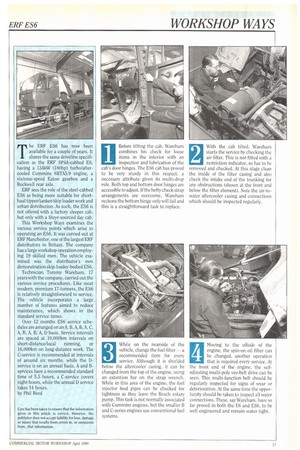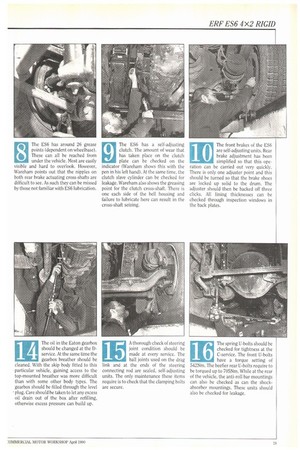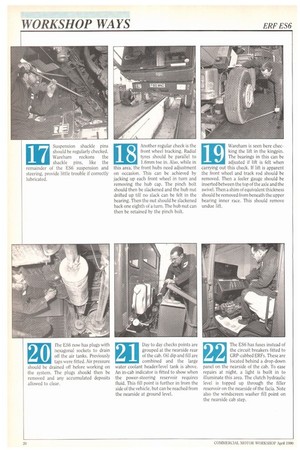WORKSHOP WAYS
Page 125

Page 126

Page 127

Page 128

If you've noticed an error in this article please click here to report it so we can fix it.
The ERF ES6 has now been available for a couple of years. It shares the same driveline specification as the ERE SP4A-cabbed E6, having a 134kW (180hp) turbo/aftercooled Cummins 6BTA5.9 engine, a six/nine-speed Eaton gearbox and a Rockwell rear axle.
ERF sees the role of the steel-cabbed ES6 as being more suitable for shorthaul tipper/tanker/skip loader work and urban distribution. As such, the ES6 is not offered with a factory sleeper cab. but only with a Steyr-sourced day cab, This Workshop Ways examines the various service points which arise in operating an ES6. It was carried out at ERF Manchester, one of the largest ERF distributors in Britain. The company has a large workshop operation employing 19 skilled men. The vehicle examined was the distributor's own demonstration skip-loader-bodied ES6.
Technician Tommy Wareham, 17 years with the company, carried out the various service procedures. Like most modern, premium 17-tonners, the ES6 is relatively straightforward to service. The vehicle incorporates a large number of features aimed to reduce maintenance, which shows in the standard service times.
Over 12 months ES6 service schedules are arranged on an A, B, A. B, A, C, A. B, A. B, A, D basis. Service intervals are spaced at 10,000km intervals on short-distance/local running, or 16,000km on long-distance work. The C-service is recommended at intervals of around six months, while the Dservice is on an annual basis. A and Bservices have a recommended standard time of 55 hours, a C-service covers eight hours, while the annual D service takes 14 hours.
by Phil Reed
Care has been taken to ensure that the information given in this article is correct. However, the publisher does not accept liability for loss, damage or injury that results from errors in, or omissions from, that information.
Before tilting the cab, Wareham combines his check for loose items in the interior with an inspection and lubrication of the cab's door hinges. The ES6 cab has proved to be very sturdy in this respect, a necessary attribute given its multi-drop role. Both top and bottom door hinges are accessible to adjust. If the hefty check strap arrangements are overcome. Wareham reckons the bottom hinge only will fail and this is a straightforward task to replace.
1
With the cab tilted. Wareham starts the service by checking the air filter. This is not fitted with a restriction indicator, so has to be removed and checked. At this stage clean the inside of the filter casing and also check the intake end of the trunking for any obstructions (shown at the front and below the filter element). Note the air-towater aftercooler casing and connections which should be inspected regularly.
While on the nearside of the vehicle, change the fuel filter-a recommended item for every service. Although it is shielded below the aftercooler casing, it can be changed from the top of the engine, using an extention bar on the strap wrench. While in this area of the engine, the fuel injector feed pipes can be checked for tightness as they leave the Bosch rotary pump. This task is not normally associated with Cummins engines, but the smaller B and C-series engines use conventional fuel systems.
Moving to the offside of the engine, the spin-on oil filter can be changed, another operation that is required every service. At the front end of the engine, the selfadjusting multi-poly yee-belt drive can be seen. This multi-function belt should be regularly inspected for signs of wear or deterioration. At the same time the opportunity should be taken to inspect all water connections. These. say Wareham, have so far proved in both the E6 and ES6, to be well engineered and remain water tight. 5 Cummins recommends that the
valve clearances of the B-Series engine are checked every 12 months. The B-Series engine has individual rocker covers for each cylinder, making this task easier. Clearances should be checked with the engine cold. Inlet clearance is 0.25mm (.010inch), exhausts 0.5mm (0.0020inch). On the exhausts side of the engine, the ES6 service schedule calls for regular checks to be made on the tightness of connections to both manifold and turbocharger. Wareham has found these connections generally remain sound. Today's turbo/aftercooled engines require that all intake and exhaust plumbing and pipe work is kept in sound air/water tight condition. Leaking joints can eventually lead to failure, or shorter than normal engine life. The ES6 engine pipe work installation has so far proved to be trouble free. Wareham indicates the flexible turbo to aftercooler trunking connections that he inspects at every service. The ES6 has around 26 grease points (dependent on wheelbase). These can all be reached from under the vehicle. Most are easily visible and hard to overlook. However, Wareham points out that the nipples on both rear brake actuating cross-shafts are difficult to see. As such they can be missed by those not familiar with ES6 lubrication. The ES6 has a self-adjusting clutch. The amount of wear that has taken place on the clutch plate can be checked on the indicator (Wareham shows this with the pen in his left hand). At the same time, the clutch slave cylinder can be checked for leakage. Wareham also shows the greasing point for the clutch cross-shaft. There is one each side of the bell housing and failure to lubricate here can result in the cross-shaft seizing.
10 The front brakes of the ES6 are self-adjusting units. Rear
brake adjustment has been simplified so that this operation can be carried out very quickly. There is only one adjuster point and this should be turned so that the brake shoes are locked up solid to the drum. The adjuster should then be backed off three clicks. All lining thicknesses can be checked through inspection windows in the back plates.
11 ES6s are fitted with a brake
air drier which requires checking and cleaning. War eham stresses that any work on this unit should be carried out only when the air is drained from the system. At the D-service the drier unit should be dismantled to clean the gauze filter at the base of the drier and also to renew the desiccant cartridge. When replacing this cartridge, it should be examined for signs of oil contamination —an indication of the compressor's condition.
12 At the front end of the
vehicle the bottom coolant hose connections can be checked. Though the B-Series engine has generally proved to be oil tight, Wareham indicates with his right hand one area where leakage has occurred. Early models occasionally leaked oil from the bottom of the engine's front cover, a problem which had to be rectified by fitting a new gasket. This problem has been overcome on later production engines by changing the assembly technique.
13 At the D-service the engine's
three mounting points should be checked. The front mounting is very accessible: the two rear points are harder to get at. Wareham here is tapping the nearside rear mounting to check for tightness.
14 The oil in the Eaton gearbox should be changed at the Dservice. At the same time the gearbox breather should be cleaned. With the skip body fitted to this particular vehicle, gaining access to the top-mounted breather was more difficult than with some other body types. The gearbox should be filled through the level plug. Care should be taken to let any excess oil drain out of the box after refilling, otherwise excess pressure can build up.
A thorough check of steering joint condition should be made at every service. The ball joints used on the drag link and at the ends of the steering connecting rod are sealed, self-adjusting units. The only maintenance these items require is to check that the clamping bolts are secure.
16 The spring U-bolts should be checked for tightness at the
C-service. The front U-bolts have a torque setting of 542Nm. The beefier rear U-bolts require to be torqued up to 705Nm. While at the rear of the vehicle, the anti-roll bar mountings can also be checked as can the shockabsorber mountings. These units should also be checked for leakage.
17 Suspension shackle pins should be regularly checked.
Wareham reckons the shackle pins, like the remainder of the ES6 suspension and steering, provide little trouble if correctly lubricated.
18 Another regular check is the front wheel tracking. Radial tyres should be parallel to
1.6mm toe in. Also, while in this area, the front hubs need adjustment on occasion. This can be achieved by jacking up each front wheel in turn and removing the hub cap. The pinch bolt should then be slackened and the hub nut drifted up till no slack can be felt in the bearing. Then the nut should be slackened back one eighth of a turn. The hub nut can then be retained by the pinch bolt.
19 Wareham is seen here checking the lift in the kingpin.
The bearings in this can be adjusted if lift is felt when carrying out this check. if lift is apparent the front wheel and track rod should be removed. Then a feeler gauge should be inserted between the top of the axle and the swivel. Then a shim of equivalent thickness should be removed from beneath the upper bearing inner race. This should remove undue lift.
20 Ihe ES6 now has plugs with nexagonal sockets to drain
off the air tanks. Previously taps were fitted. Air pressure should be drained off before working on the system. The plugs should then be removed and any accumulated deposits allowed to clear.
21 Day to day checks points are grouped at the nearside rear
of the cab. Oil dip and fill are combined and the large water coolant header/level tank is above. An in-cab indicator is fitted to show when the power-steering reservoir requires fluid. This fill point is further in from the side of the vehicle, but can be reached from the nearside at ground level. The ES6 has fuses instead of the circuit breakers fitted to GRP-cabbed ERFs. These are
located behind a drop-down panel on the nearside of the cab. To ease repairs at night, a light is built in to illuminate this area. The clutch hydraulic level is topped up through the filler reservoir on the nearside of the facia. Note also the windscreen washer fill point on the nearside cab step.
















































































































































